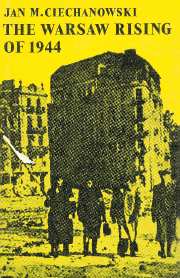Book contents
- Frontmatter
- Contents
- Abbreviations
- Acknowledgements
- Introduction
- Map
- 1 The Big Three and Poland: July 1943–July 1944
- 2 The Genesis of the Polish Resistance Movement
- 3 Attempts to Unify the Polish Resistance Movement
- 4 The Polish Grand Strategy, 1941–1943
- 5 The ‘Tempest’ Plan
- 6 The London Poles and ‘Tempest’
- 7 The ‘Tempest’ East of Warsaw
- 8 The Fate of Warsaw
- 9 Why Warsaw Rose
- 10 Warsaw and the Émigré Leaders
- Conclusions
- Bibliography
- Index
3 - Attempts to Unify the Polish Resistance Movement
Published online by Cambridge University Press: 04 August 2010
- Frontmatter
- Contents
- Abbreviations
- Acknowledgements
- Introduction
- Map
- 1 The Big Three and Poland: July 1943–July 1944
- 2 The Genesis of the Polish Resistance Movement
- 3 Attempts to Unify the Polish Resistance Movement
- 4 The Polish Grand Strategy, 1941–1943
- 5 The ‘Tempest’ Plan
- 6 The London Poles and ‘Tempest’
- 7 The ‘Tempest’ East of Warsaw
- 8 The Fate of Warsaw
- 9 Why Warsaw Rose
- 10 Warsaw and the Émigré Leaders
- Conclusions
- Bibliography
- Index
Summary
Attempts to Unite the Resistance in Poland
The Association for Armed Struggle (ZWZ) was formed in January 1940 as the nucleus of the future Home Army. It was hoped that its leaders, as the representatives of the Polish Government, would be able to bring under their control and consolidate all resistance forces in the country, so creating a fully representative national movement which would shape and follow policies reflecting Sikorski's strategic and political plans. The exercise of control on this scale would also be of considerable value at the end of the war, in helping the pro-London leaders to emerge as the undisputed leaders of Poland, as it would ease their assumption of power at the political and administrative helm of the nation. The existence of a single military underground organisation would be a safeguard against the dangers of ill-co-ordinated action against the Germans and civil strife after, or even during the war. It would mean more efficient utilisation of the resources of resistance and the creation of a force capable, during the final stages of the war, of launching the nation-wide insurrection which was to be the crowning achievement of the Polish underground.
For these reasons, in establishing the Association the exiled authorities categorically stated that, thenceforth, only one military underground organisation should exist in Poland; the military elements of other organisations were told to place themselves at the disposal of the ZWZ. In 1942 Sikorski decided to re-name the ZWZ the Home Army (Armia Krajowa – AK) to emphasise the fact that it was an integral part of the Polish Armed Forces loyal to the exiled Government.
- Type
- Chapter
- Information
- The Warsaw Rising of 1944 , pp. 84 - 128Publisher: Cambridge University PressPrint publication year: 1974



